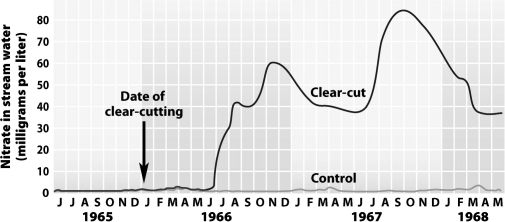In the Hubbard Brook Experimental Forest in New Hampshire, a portion of the forest was first clear-cut, then sprayed with herbicides for 3 years to prevent growth. A second portion of the forest was not clear-cut or sprayed and served as a control plot. The graph below shows that nitrate, a form of nitrogen that is important to plants, was lost from the ecosystem in streams at a much higher rate in the clear-cut portion of the forest than in the control portion. 
What best explains the small releases of nitrogen from the control portion of the forest at the Hubbard Brook Experimental Forest?
A) Its nitrogen was sequestered in the forest biomass and temporarily unavailable.
B) With intact vegetation to intercept the acid rain that falls in the area it failed to reach the soil and chemically react to release the nitrogen.
C) With intact vegetation, rainwater washed little soil and nitrogen from the forest floor.
D) All of the above contributed to the small amount of nitrogen loss.
Correct Answer:
Verified
Q20: Over time,the total amount of nutrients such
Q23: Human activities
A) rarely affect nutrient cycles.
B) can
Q30: The impacts of acid rain
A) are quickly
Q34: Cutting a forest to produce paper bags
Q35: Secondary productivity can never exceed primary productivity
Q37: The figure below illustrates how nutrients cycle
Q37: The dead zone that develops in the
Q38: Which of the following would most likely
Q40: Within the ecosystem,nutrients
A) move in a one-way
Q41: The term ecosystem services is used to
Unlock this Answer For Free Now!
View this answer and more for free by performing one of the following actions

Scan the QR code to install the App and get 2 free unlocks

Unlock quizzes for free by uploading documents